Applying a patina to the knife’s surface will improve its looks as well as functionality. There are many ways to do this, but natural solutions are the best. Our process only requires vinegar and simple tools that can be found around the house.
Once you’re done reading this guide, you’ll be equipped with useful practical information. Stay with us to learn about different colors, surface textures and other possibilities.
Throughout this article, we’ll talk about different parts of this process. You’ll learn about materials and gain an insight on how Patina will affect the blade.
Is Vinegar A Good Knife Patina Solution?
Vinegar is the most widely used solution to patina a knife. Generations of knife-owners wouldn’t continue using it if it wasn’t effective. It’s a natural substance that works very well.
Why Force A Patina On A Knife?
Patina protects your knife from natural rusting. The blade develops a thin layer of protective coating, which will protect it from natural corrosion.
Except for its practical benefits, a Patina can also give your blade an old-fashion, handmade look.
How Many Types Of Vinegar To Patina Knife With?
You can use numerous different types of vinegar to Patina your knife. The most popular types are Apple cider, white vinegar, rice vinegar. Distilled white vinegar, with a PH balance of 2.5, has the fastest results.
Method 1: Using Hot Vinegar For Knife Patina
The most common method of applying Patina to your knife involves dipping your blade in heated vinegar. Let’s look into the actual process.
Why Hot Vinegar Instead Of Vinegar?
Room temperature vinegar works much slower. It can take hours to patina a knife using simple vinegar. Even then, the layer might not last very long.
Experts heat the vinegar to speed up the chemical reactions. A blade dipped in hot vinegar will develop Patina much faster.
Items You’d Need
- Portable hotplate (or similar)
- Heat-resistant gloves
- Tongs for picking up hot items
- Container
- Vinegar
- Cloth
Step 1: Prepare to boil
Go outside and turn on the heat on your appliance. When heated up, vinegar omits an unpleasant scent. This is why you should set up your heating appliance outside of your house. As a last-case scenario, you must leave your windows open so that the air flows.
Step 2: Start heating
Pour vinegar into the container. Make sure to choose a compatible container. We recommend using a tin can since it is easily disposable. Once the container is full, place it on a hot plate and wait 2-3 minutes.
Step 3: Check the progress
Take your blade and place it in hot vinegar. Let it sit for 5-20 minutes. The exact timeframe will depend on vinegar’s temperature and the type of vinegar used. The hotter the vinegar, the faster the reaction will be. The bubbles on the surface of the blade are a sign that the chemical reaction is going on.
You can periodically take out the blade with a tong to check the progress. If you notice a consistent coating on your blade, the process is nearly finished. If you notice few discolored spots, put the blade back into vinegar and wait few more minutes.
Step 4: Final Conditioning
Take your blade out and wipe off the remaining vinegar. Let it sit for at least 20 minutes so that the blade comes in contact with oxygen in the air. Follow up by rinsing the blade in hot water and gently wiping it off.
How Would The Patina Look Like?
After Patina, your blade will take on a dark color. The exact shade will depend on the type of vinegar that you use.
Putting your knife in boiled Apple Cider vinegar will result in black color:
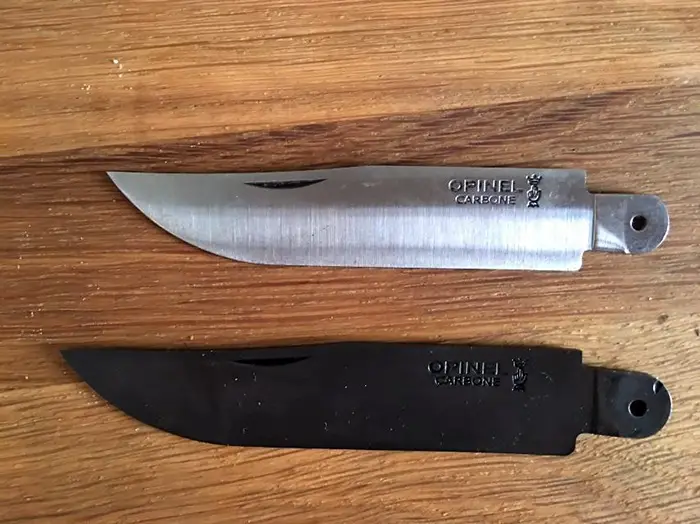
White vinegar will give it a lighter, grey color:
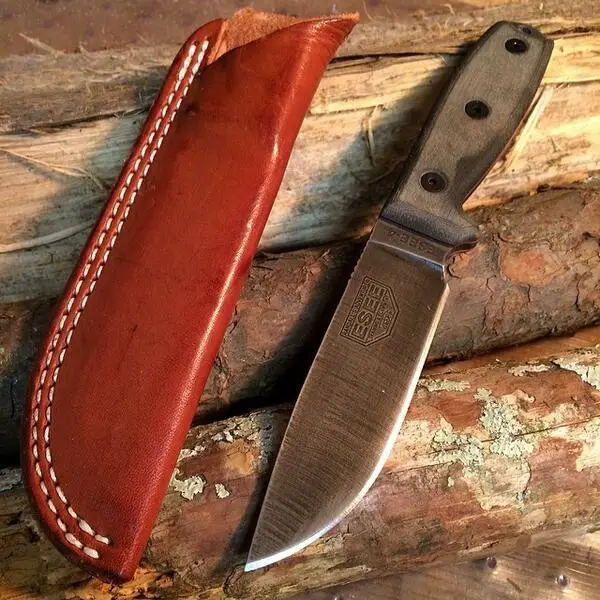
Tips And Precautions
- Don’t boil vinegar inside your home
- Thoroughly clean the surface of your blade.
Method 2: Using Apple Cider Vinegar For Knife Patina
You can also use Apple Cider Vinegar to Patina your knife. Putting the knife through controlled corrosion will make it corrosion resistant. Apple Cider Vinegar is effective at room temperature, but the process goes faster if it’s heated up.
Why Apple Cider Vinegar Instead Of Vinegar?
Apple Cider Vinegar has the highest pH of all vinegar types. If you Patina your knife with this substance, it will acquire a distinguished black color. Acids contained in Apple Cider Vinegar will also make your blade look more authentic or even handmade.
This type of vinegar is highly effective and works even at room temperature. Increasing the temperature also increases its efficiency.
Items You’d Need
- Apple Cider Vinegar
- Container of appropriate size
- Cloth
Step 1: Select the container
Fill your container with apple cider vinegar. You can minimize the waste by choosing a tall and narrow container. This way, the entire surface of your blade will be covered by ACV.
Step 2: Start the process
Put your blade inside the container. Make sure the entire surface of the blade is submerged.
Step 3: Check the progress
Let your knife sit in the vinegar for 3-4 hours. Periodically take out the blade and see if it’s getting darker. If you decided to use heated ACV, the process will go faster. It will take about 10-20 minutes to Patina your knife in hot apple cider vinegar.
Vinegar that was left at room temperature will take much longer to have a visible effect. It’s safe to keep your blade in the container overnight.
Step 4: Take it out
Take out the knife and let it dry for at least half an hour. Afterward, rinse it with warm water and dry it with a cloth.
How Would The Patina Look Like?
Apple Cider Patina will give your knife a sharp black color. Here’s the before/after picture:
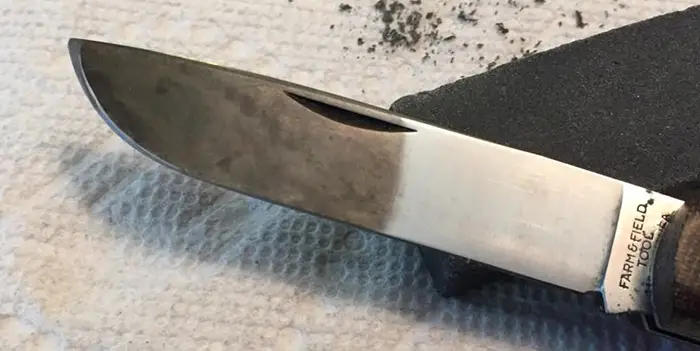
Tips And Precautions
- Heat up the vinegar for faster results
- Do not scrub freshly patinated knife
Method 3: Using Diluted Vinegar For Knife Patina
You can use a 50/50 mix of water and vinegar to apply a more consistent Patina. Let’s look into the specifics of using this mixture.
Why Diluted Vinegar Instead Of 100% Vinegar?
Acidic solutions are indeed necessary to Patina a knife. Still, highly acidic chemical makeup doesn’t automatically translate to better results. In some cases, a diluted mix works much better than 100% vinegar. Many other factors influence the speed and outcome of the process.
The knife must be exposed to oxygen to develop a Patina. Regardless of what method you use to Patina a knife, it must be left in the open air for some time.
Mixing acidic vinegar with water has the same effect. Water contains oxygen, so by mixing it with vinegar you get a perfect solution.
Items You’d Need
- Water
- Vinegar
- Container
- Blade
- Vegetable oil (optional)
Step 1: Select the ingredients
Get the necessary ingredients (water and vinegar). Fill the container with vinegar and add water.
Step 2: Insert the knife
Place your knife inside the mixture. Make sure that the mix covers only the surface of the blade, not the handle. Coming in contact with vinegar might ruin the aesthetics of a wooden handle. Position the blade carefully when you’re placing it in the mixture.
Step 3: Check for results
Wait for at least 3-4 hours for the results. Acidification of the surface will take much longer at room temperature. You are free to periodically check the condition of the knife. You should notice a shade of black after at least one hour.
If you don’t want a perfect black color, you can always take the knife out of the mix prematurely.
Step 4: Final Conditioning
Take out the blade, gently wash off the liquids with a cloth and let it dry. Sometimes, knives might leave a black trace when you use them to cut the food. This problem will eventually go away by itself. However, if you want it resolved fast, you can try washing the knife with soap.
Don’t apply too much force when cleaning the blade. You might remove some of the patina. Let it dry before rubbing it too hard.
If you’ve recently applied a Patina to a knife, it can have a slight smell of vinegar. To remove this smell, you must cover the surface with vegetable oil and let it sit for a while. Afterward, clean the blade with a cloth and the smell should be gone.
How Would The Patina Look Like?
The picture below shows the effect of Patina on a blade:
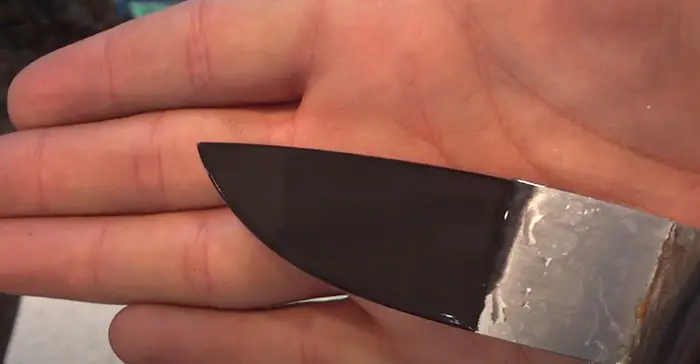
Tips And Precautions
- Make sure you don’t use too much water
- Don’t apply too much force when cleaning the newly coated knife.
Method 4: Using 100% Vinegar For Knife Patina
100% vinegar can be used to apply a patina. The process is a little different. Still, pure vinegar can work just as well as concentrated vinegar.
Why 100% Vinegar Instead Of Diluted Vinegar?
To Patina a knife, you need to trigger a chemical reaction. Diluted vinegar works well because water naturally includes oxygen. However, using water is not the only way to provide oxygen.
In the case of 100% vinegar, you oxygenate it in other ways. For instance, you can leave it to dry in the open air. Oxygen particles in the air will come in contact with the knife and have the same effect.
Pure vinegar also contains more acids, which can lead to a faster process. 100% vinegar works even better and faster when it is heated up.
Items You’d Need
- Protective gear (if you heat up the vinegar)
- 100% vinegar
- Container
- Cloth to wipe
Step 1: Prepare
Find the container and fill it with vinegar. Because you’re using 100% vinegar, try to use a tall and narrow container. That way, you won’t waste a lot of the substance.
If you’re planning to heat up the vinegar, use a container that can be safely heated. Using a tin can is a good idea. It is a simple, easily disposable container.
Step 2: Insert the blade
Place your blade in the vinegar. If you decided to keep it at room temperature, the process will take few hours. It’s a good idea to let the blade sit in the vinegar throughout the night. In the morning, you should notice a nice black coating.
As time passes, the chemical reaction will slowly fade out. So don’t worry about keeping the knife submerged for too long.
Step 3: Check the Progress
Remove the knife from the container and inspect it. Look at the surface and check if it has acquired the desired shade. The longer you keep the blade in the vinegar, the darker the shade will be.
If you notice the spots on the knife’s surface, put the blade back. Let it sit for few hours more.
Step 4: Final Conditioning
Once Patina is complete, take out the knife and let it sit in the open air. Wait 30-60 minutes until it’s dry. Afterward, rinse your knife with warm water and carefully dry it with a cloth.
How Would The Patina Look Like?
Once the process is finished, it should look entirely black or grey. The exact color will depend on the amount of time the knife spent in the vinegar. The surface shouldn’t have any shiny spots.
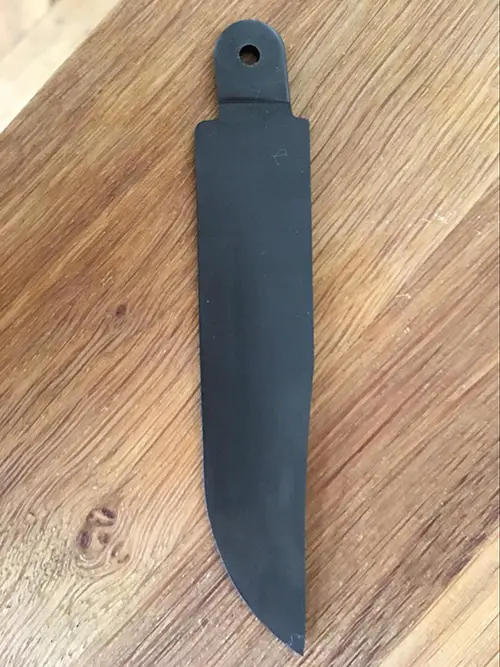
Tips And Precautions
- Heated vinegar will produce an unpleasant smell. Heat it up outside the house.
- Keep the blade in the vinegar until all inconsistencies are gone
The Impact Of Vinegar Ph For Knife Patina
Forcing patina on a knife comes down to exposing it to acids and oxygen. The acidity of any substance can is measured by the pH value. These days, people use many different types of vinegar to patina a knife. Each type of vinegar has a different level of acidity. It is important to find out the pH value of vinegar before using it to Patina a knife. Otherwise, you might end up with unexpected results.
When you patina a knife, results can be hard to predict. Determining the pH value of vinegar can bring you some clarity in this regard. For instance, white vinegar has an acidity level of 2.5. The pH value can give us the following information:
Color: pH value gives you the ability to predict the color of Patina. Placing the blade in white vinegar will make its surface grey matte. Technically, it’s possible to achieve black color, but it will require a more intense, repeated process. The kinds of vinegar with high pH values will give your knife a darker and more consistent black color. You can get a darker shade of black if you heat up the vinegar.
Speed: pH value can help you predict how long it will take to patina your knife. Heat is the most important factor for chemical reactions, but it’s not the only one. Kinds of vinegar with lower pH values (for instance, white vinegar) tend to work faster at room temperature. Especially when compared to vinegars with high values (apple cider vinegar).
How Long Vinegar Knife Patina Last?
The effects of controlled corrosion, also known as patina, are not permanent. Any patina will eventually disappear sooner or later. The longevity of a Patina depends on many different factors:
- Frequency of use
- The process used to apply a patina
- Type of vinegar you used
- Material of a blade
- Treatment of a blade
When you use vinegar to patina a knife, you can start using the blade right away. However, after each use, it is recommended to give it a rinse. In the best-case scenario, you can give it an oil treatment. Spread oil to cover the entire surface, let it sit, and rinse after few minutes. This procedure should ensure the longevity of a patina layer.
It is commonly believed that white vinegar is the best type to use. Knives patinated with white vinegar tend to last longer.
You can also go through the Patina process multiple times. This will result in a stronger, more pronounced color and the coating will last longer.
Knife Patina: Vinegar Vs Mustard
Vinegar is not the only natural solution used to Patina a knife. Mustard Is another highly acidic substance that you can use to achieve the same results.
| Vinegar Knife Patina | Mustard Knife Patina | |
| Application | Blades are submerged | Applied as a paste |
| Primary use | Covers the entire surface | Applied to specific parts of the knife |
| Color | Black or grey | Varied colors |
Application
In order to patina a knife with vinegar, you must follow a simple process. Fill the container with the liquid and insert your blade. The submerged surface of your knife will eventually change color.
Mustard, on the other hand, is applied as a paste.
Primary Use
Vinegar is used to patina the entire surface of the blade.
People use mustard to color certain parts of a knife. It is often used to draw a pattern.
Color
Depending on the process and grade of the steel, mustard can leave many different colors. Vinegar usually produces grey or black color.
Knife Patina: Vinegar Vs Lemon Juice
Lemon juice is a highly acidic substance. It is also easily available. That’s why so many people use it to patina their knives.
| Vinegar Knife Patina | Lemon Juice Knife Patina | |
| Speed | Slower reaction | Faster at room temperature |
| Application | Blades are submerged | Multiple methods |
| Hamon | Almost invisible | Very distinct |
Speed
When left at room temperature, both substances take few hours to Patina a knife. Still, lemon juice works slightly faster. When using this substance, it only takes 1-2 hours to patina a knife.
It is important to note that vinegar works within a matter of minutes when heated up. High temperature accelerates the speed of chemical reaction, so the Patina is visible much faster.
Application
When you use vinegar to patina a knife, it must be completely submerged in the liquid.
Lemon juice patina can be applied in many different ways. One way is to use as you’d use the vinegar. You can also apply lemon juice to the surface. To patina a knife, you can also stab the lemon and leave the knife inside the fruit for few hours.
Hamon
Hamon, also known as tempering line is prominent when you use lemon juice to patina a knife. It is harder to distinguish when you use vinegar.
Frequently Asked Questions
Patina is a fascinating concept. Naturally, people are curious about the details.
Will Vinegar Patina Stainless Steel?
A good stainless steel blade is going to be corrosion-resistant. You can not apply a patina if your steel is rust-proof. However, purely stainless steels are very rare. Your knife will probably get in reaction with vinegar after an extended period of time.
Will Vinegar Patina Copper?
Copper is a material that is naturally inclined to develop a patina layer. This process can be sped up by the use of vinegar.
Will Vinegar Patina Brass?
You can use vinegar to forcefully patina brass materials. There are many other ways to patinate Brass, but using vinegar is one of the fastest.
What Is Patina On A Knife Blade?
Patina is essentially controlled corrosion for metal objects. The intention is to protect the surface from natural rusting. Some people use Patina decoratively.
Is Knife Patina Bad?
Naturally rusting knives aren’t good. However, rusting can be delayed if you patina your knife. You can also use it to draw interesting patterns or give your knife a nice color.
Closing Words
Anyone who loves knives should try to patina their blades at least once. If you liked chemical experiments as a child, you are guaranteed to love this process as well.
If you love knives, you can experiment with this process to try something new. You can use the methods we described to give your knifes a new color or interesting pattern. The possibilities are endless.
- How Long Does Vegan Butter Last? Mystery Solved - January 9, 2024
- How Long Does Vegan Mayo Last - January 2, 2024
- From Pot to Plate: How Long Does Vegan Chili Last in The Fridge? - December 26, 2023

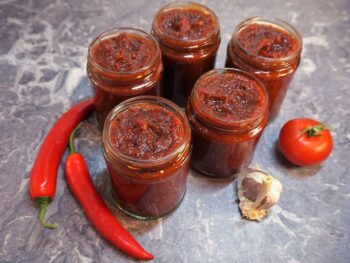
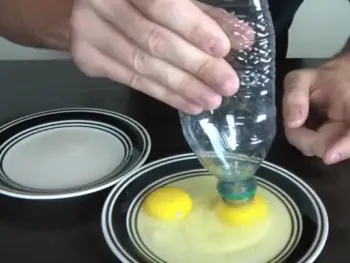

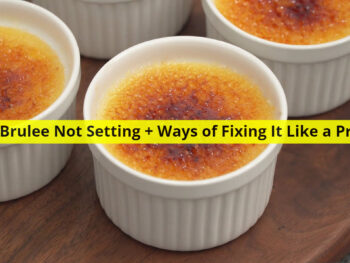

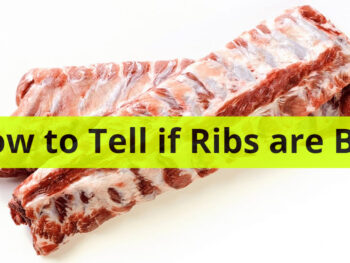




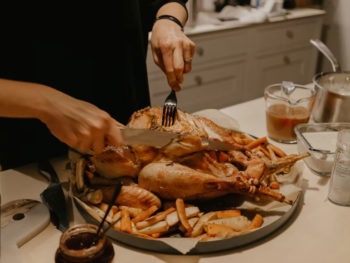
 Papa John’s Pizza Sauce Recipe for Your Late Night Pizza Cravings
Papa John’s Pizza Sauce Recipe for Your Late Night Pizza Cravings